The Complete Guide to Employee Compensation and Benefits
Unlock top employee compensation benefits strategies to boost motivation, retention, and competitive edge. Understand structures and improve today!
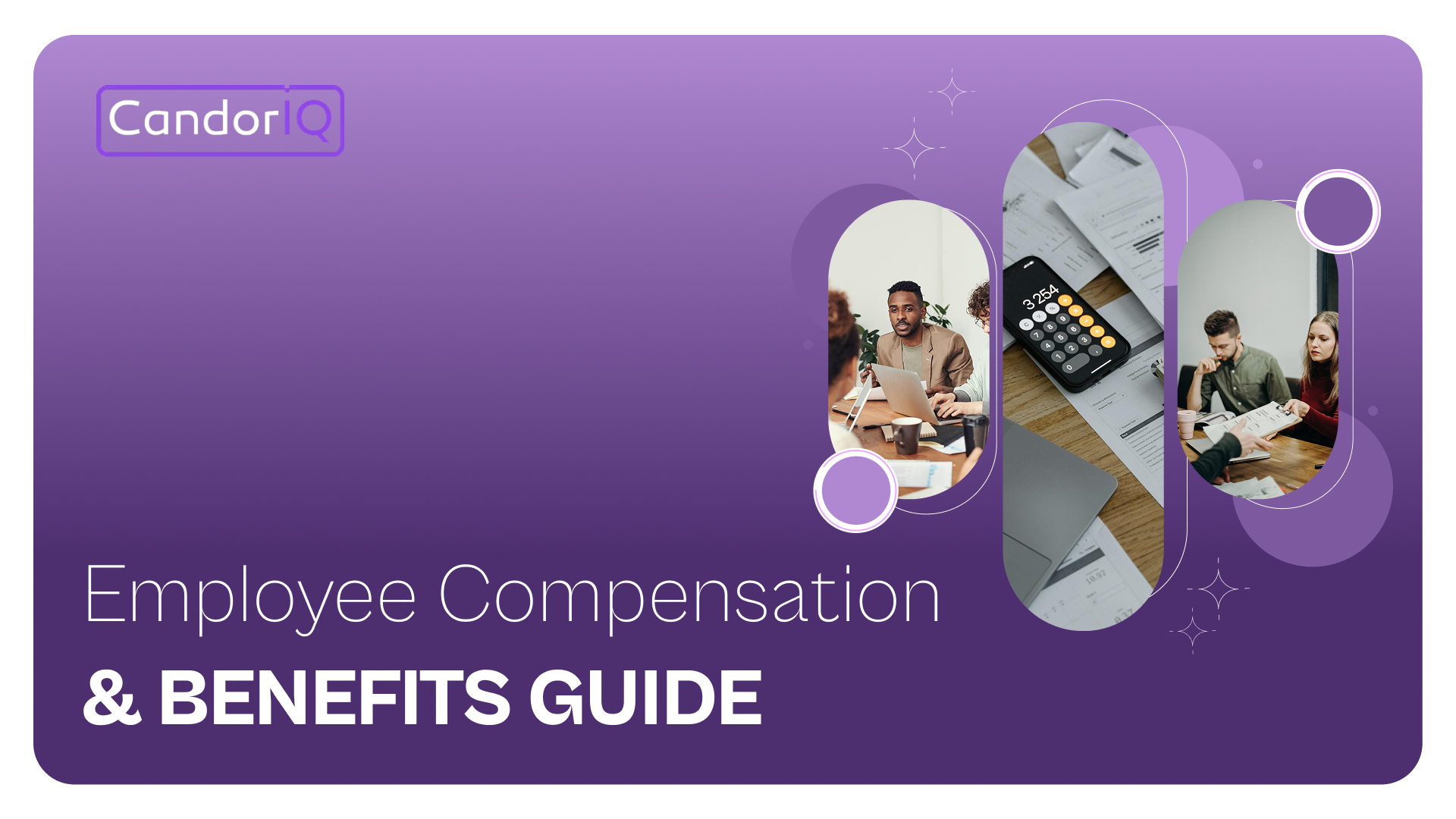
Crafting the right compensation and benefits package is a key part of attracting and keeping the best talent. But with so many components, it’s easy to get lost in the details.
To build a package that your employees rejoice in and which stays within your budget, it's essential to understand the right balance between financial rewards and benefits.
Today, we will guide you in making an effective employee compensation benefits plan and in structuring it for success.
TL;DR
- Employee compensation benefits include both direct pay and non-monetary perks like health insurance, bonuses, and flexible working arrangements.
- Understanding employee compensation benefits is essential for attracting and retaining top talent, boosting engagement, and ensuring compliance with legal regulations.
- Employee compensation encompasses base salary, performance-based pay, employee benefits, and non-monetary perks.
- Key components of employee benefits include health insurance, paid time off (PTO), retirement plans, and equity compensation.
- Trends such as pay equity, remote work compensation, and non-monetary benefits are shaping the future of employee compensation.
What Are Employee Compensation and Benefits?
Employee compensation refers to the financial rewards provided to employees in return for their work, making up the bulk of their earnings. This includes the base salary and other financial incentives such as bonuses, commissions, and performance-related rewards.
These payments are often directly tied to the employee's job role, performance, and the company’s financial health, and are typically subject to taxation.
Employee benefits, on the other hand, go beyond the direct financial rewards and encompass non-monetary offerings that contribute to an employee’s overall well-being. These may include essential benefits such as health insurance, paid time off (PTO), retirement contributions, and wellness programs.
Key Differences: Compensation vs. Benefits
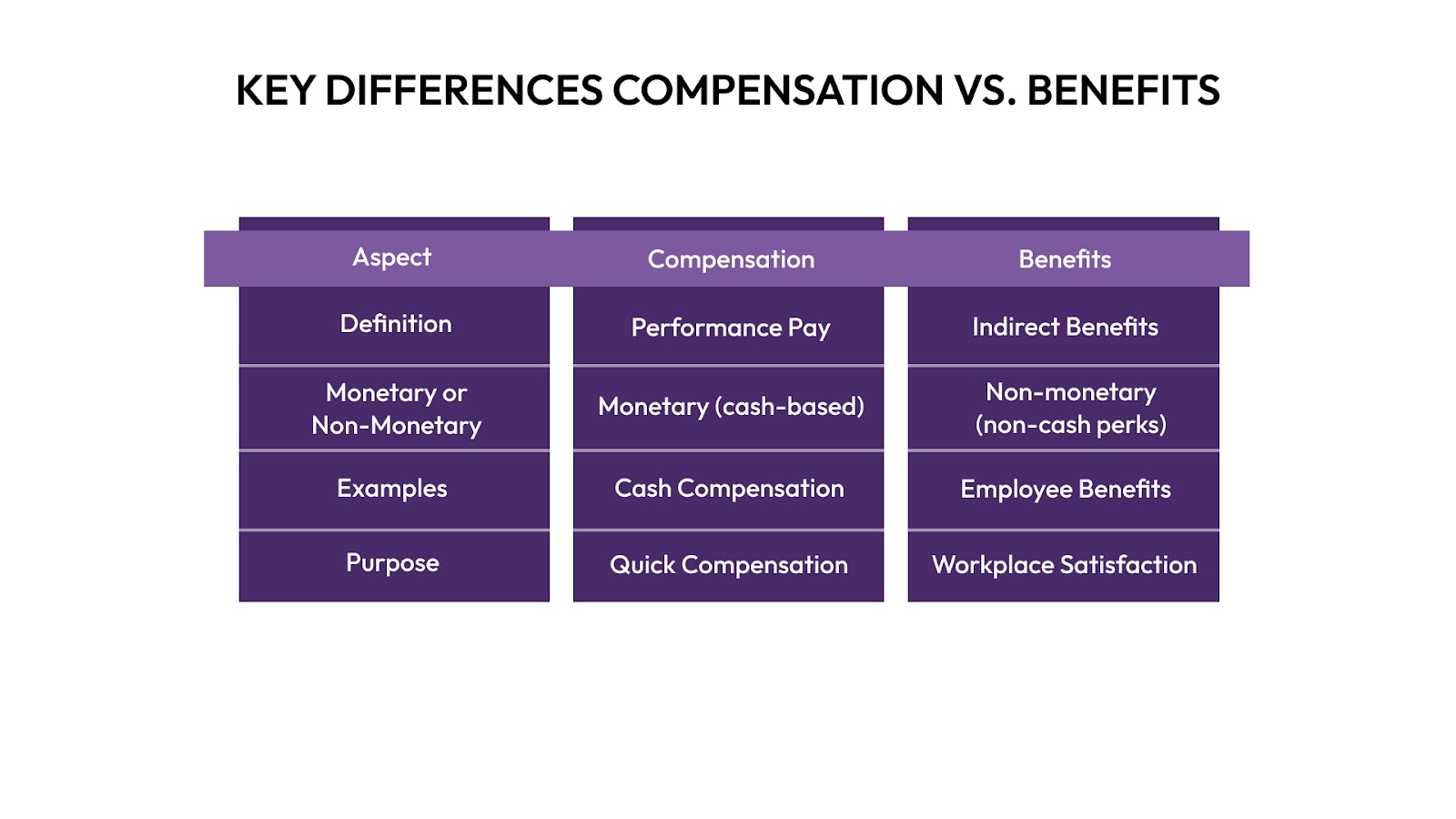
Compensation and benefits are both essential parts of an employee’s total pay package, but they differ in nature and purpose.
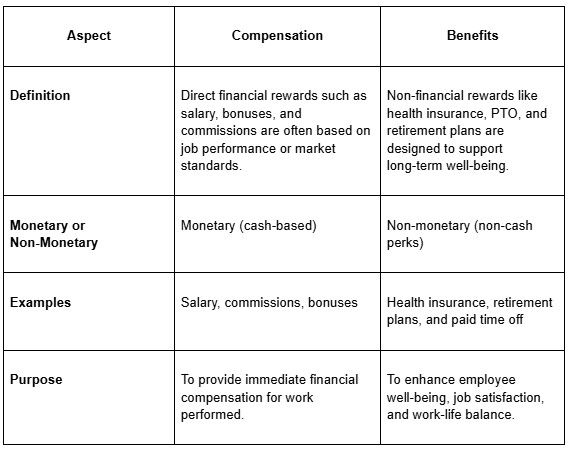
Now, it’s time to understand how these elements directly impact employee motivation, retention, and the organization's overall success.
The Importance of Employee Compensation Benefits
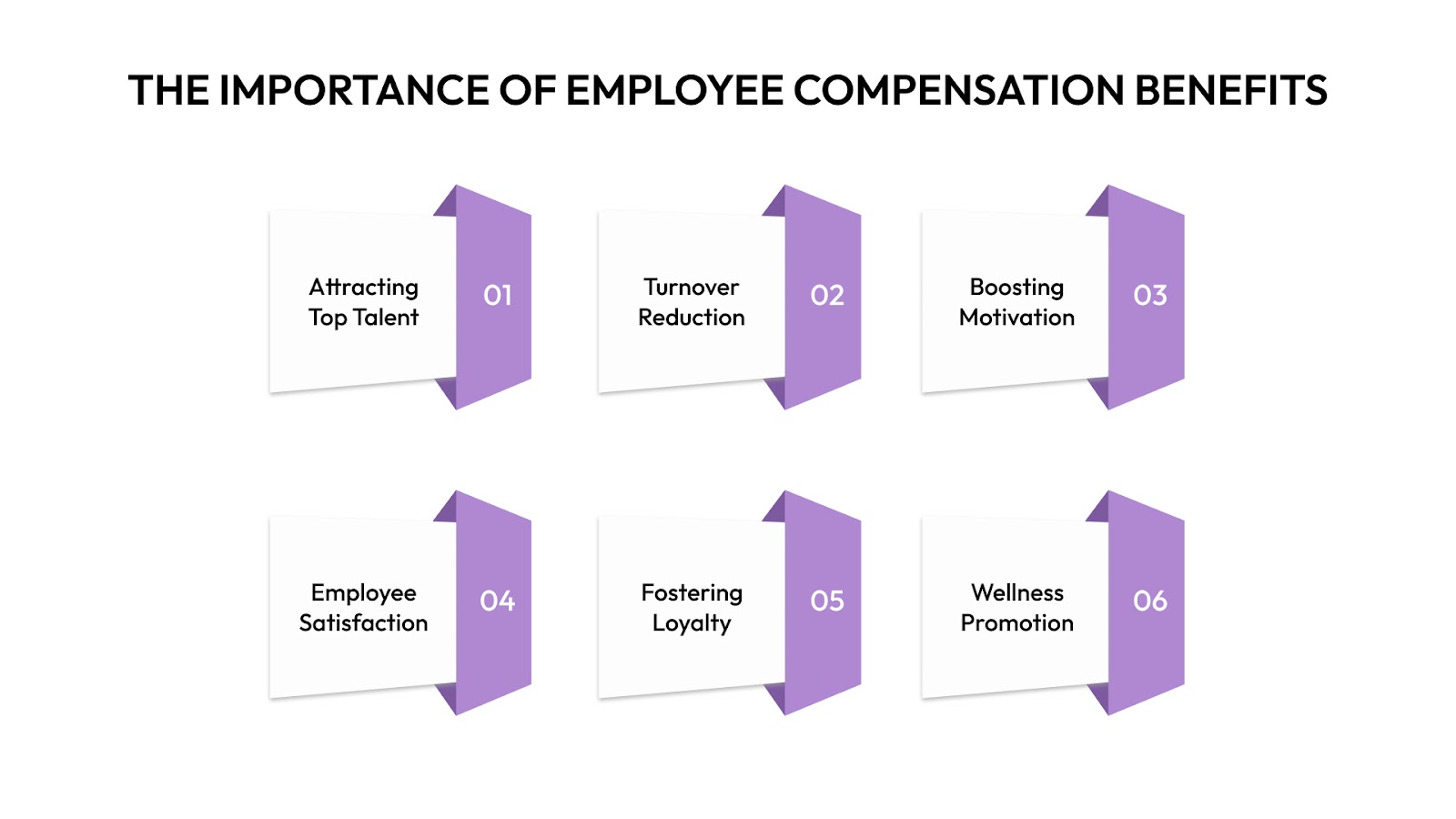
A well-structured employee compensation benefits package is essential for business success, as it directly influences talent attraction, employee retention, and overall job satisfaction.
- Attracting Top Talent: A competitive compensation and benefits package makes your company more appealing to high-quality candidates, offering them not just a salary but a comprehensive suite of perks that enhance their lifestyle.
- Reducing Employee Turnover: Offering employee benefits like healthcare, retirement plans, and paid time off (PTO) increases employee retention by making them feel secure and valued in the workplace.
- Boosting Motivation: Performance-based pay and bonuses tied to individual or team success can significantly boost motivation, encouraging employees to go above and beyond in their roles.
- Improving Employee Satisfaction: Benefits like wellness programs, flexible work arrangements, and stock options enhance employee satisfaction by offering them both work-life balance and a stake in the company’s future.
- Fostering Loyalty: When employees receive benefits like paid family leave and employee assistance programs, they feel supported in times of need, building a strong sense of loyalty and commitment to the organization.
- Promoting Health and Well-being: Comprehensive health insurance, including mental health benefits, shows employees that their well-being is a top priority, improving job satisfaction and productivity.
Once you understand the employee compensation benefits, we can proceed to learn about their components.
Components of Employee Compensation and Benefits
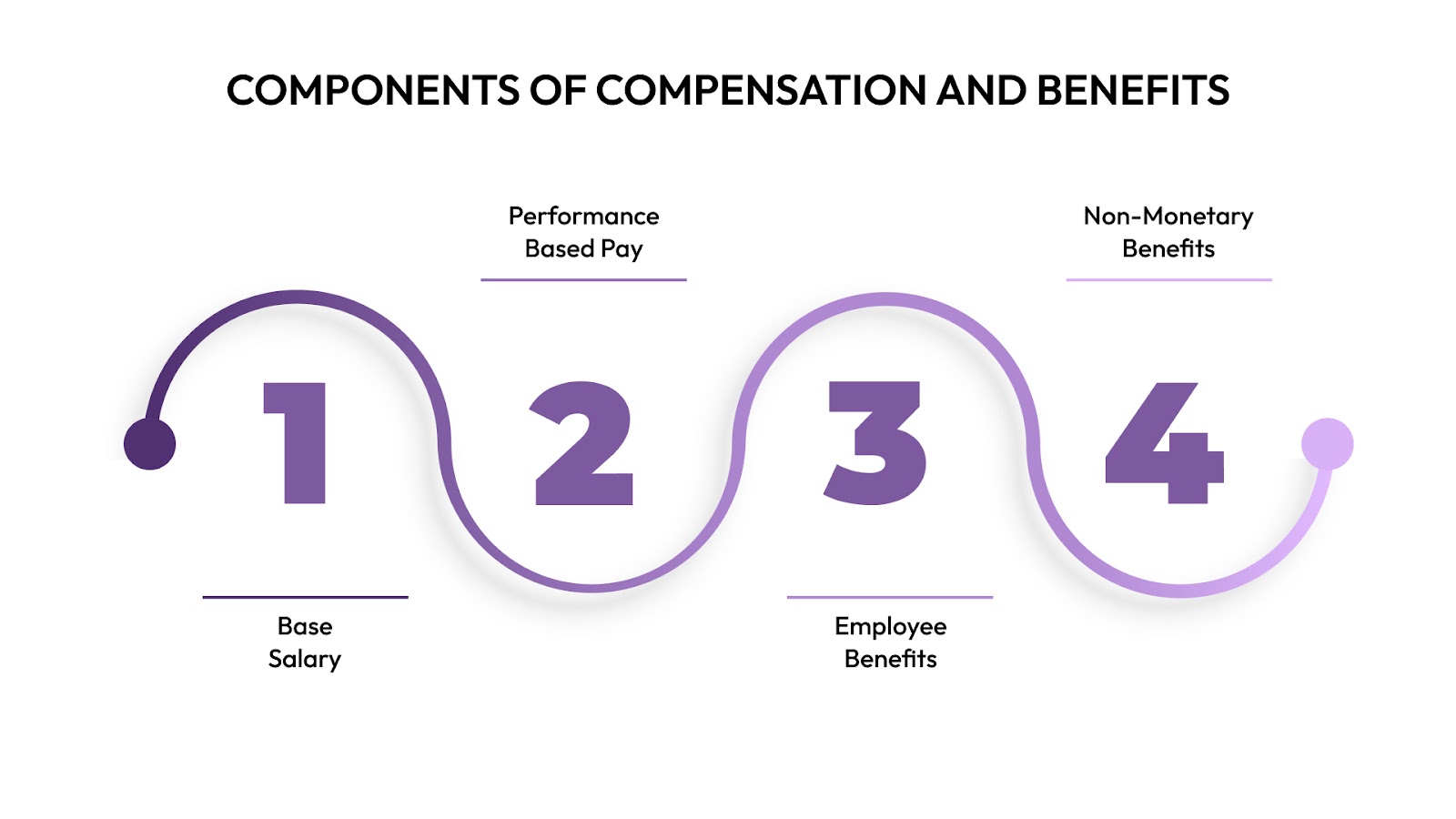
To build a truly effective employee compensation benefits package, it’s essential to understand the individual components that come together to form a competitive and appealing offer.
1. Base Salary
Base salary is the fixed pay an employee receives, either on an hourly or annual basis. It is the cornerstone of any compensation package, setting the financial foundation for an employee’s earnings.
- Fixed Amount: Paid regularly, either annually or on an hourly basis, depending on the employee's role.
- Determined by Market Factors: Influenced by the employee's role, industry standards, geographical location, and experience.
- Stability: Provides employees with a predictable and consistent income, which is essential for effective financial planning.
- Regular Reviews: Typically reassessed annually to ensure it remains competitive with market trends.
2. Performance-Based Pay
Performance-based pay ties compensation to an employee's or team's performance against set targets, encouraging productivity and aligning personal goals with company objectives.
- Bonuses: Rewards for achieving or exceeding performance goals, typically given on a quarterly or annual basis.
- Commissions: Common in sales and business development roles, commissions are paid based on the revenue or business brought in by the employee.
- Incentive Pay: Offered as extra motivation, often linked to individual or team accomplishments (e.g., hitting sales goals).
- Profit Sharing: A system where employees share in the company’s profits, fostering a sense of ownership and contribution to company success.
3. Employee Benefits
Employee benefits go beyond direct pay, offering a variety of perks and support that enhance employees' quality of life and promote long-term well-being.
- Health & Wellness:
- Health Insurance: Coverage for medical, dental, and vision care, often including both individual and family plans.
- Mental Health Support: Programs include counseling services and stress management workshops.
- Wellness Programs: Fitness memberships, gym reimbursements, and other wellness-related perks.
- Retirement Plans:
- 401(k) Contributions: A typical retirement savings plan where employers match a portion of employee contributions.
- Pension Plans: Employer-funded plans provide a steady income after retirement.
- Other Retirement Benefits: IRAs or other savings programs designed to secure an employee's future.
- Paid Time Off (PTO):
- Vacation Days: Paid days off for rest, often tied to years of service.
- Sick Leave: Paid time off to recover from illness, ensuring employees don’t lose income during their recovery.
- Parental Leave: Paid or unpaid leave provided to employees for childbirth, adoption, or family care.
- Equity Compensation:
- Stock Options: Grants employees the right to purchase company stock at a future date, usually at a discounted rate.
- Restricted Stock Units (RSUs): Stocks awarded as part of an employee’s compensation package that vest over time.
- Profit-Sharing: A form of compensation where employees receive a share of the company’s profits, motivating them to contribute to the company’s success.
4. Non-Monetary Benefits
Non-monetary benefits are perks that improve employees' overall job satisfaction and work-life balance, without involving direct cash compensation. These benefits foster a positive workplace environment and contribute to long-term loyalty.
- Flexible Work Arrangements:
- Remote Work: Options to work from home or anywhere else, reducing the need for commuting.
- Flexible Hours: Allowing employees to set their schedules within certain limits, providing better work-life integration.
- Job Sharing: Two employees share a single full-time position, offering increased flexibility.
- Career Development:
- Training & Education: Providing employees with opportunities to attend conferences, workshops, and courses to develop new skills.
- Leadership Programs: Offering specialized programs to help employees grow into leadership roles.
- Mentorship: Connecting employees with mentors for career guidance and professional development.
- Recognition Programs:
- Employee of the Month: Recognizing employees for outstanding performance and contributions.
- Spot Bonuses: Offering immediate, on-the-spot rewards for exceptional performance.
- Celebrations: Acknowledging significant milestones like work anniversaries or achievements with gifts or events.
These components of employee compensation benefits combine to create a competitive and holistic package that meets the needs of employees while aligning with company goals.
Now, let’s learn how to design a competitive employee compensation package.
How to Design a Competitive Employee Compensation Package
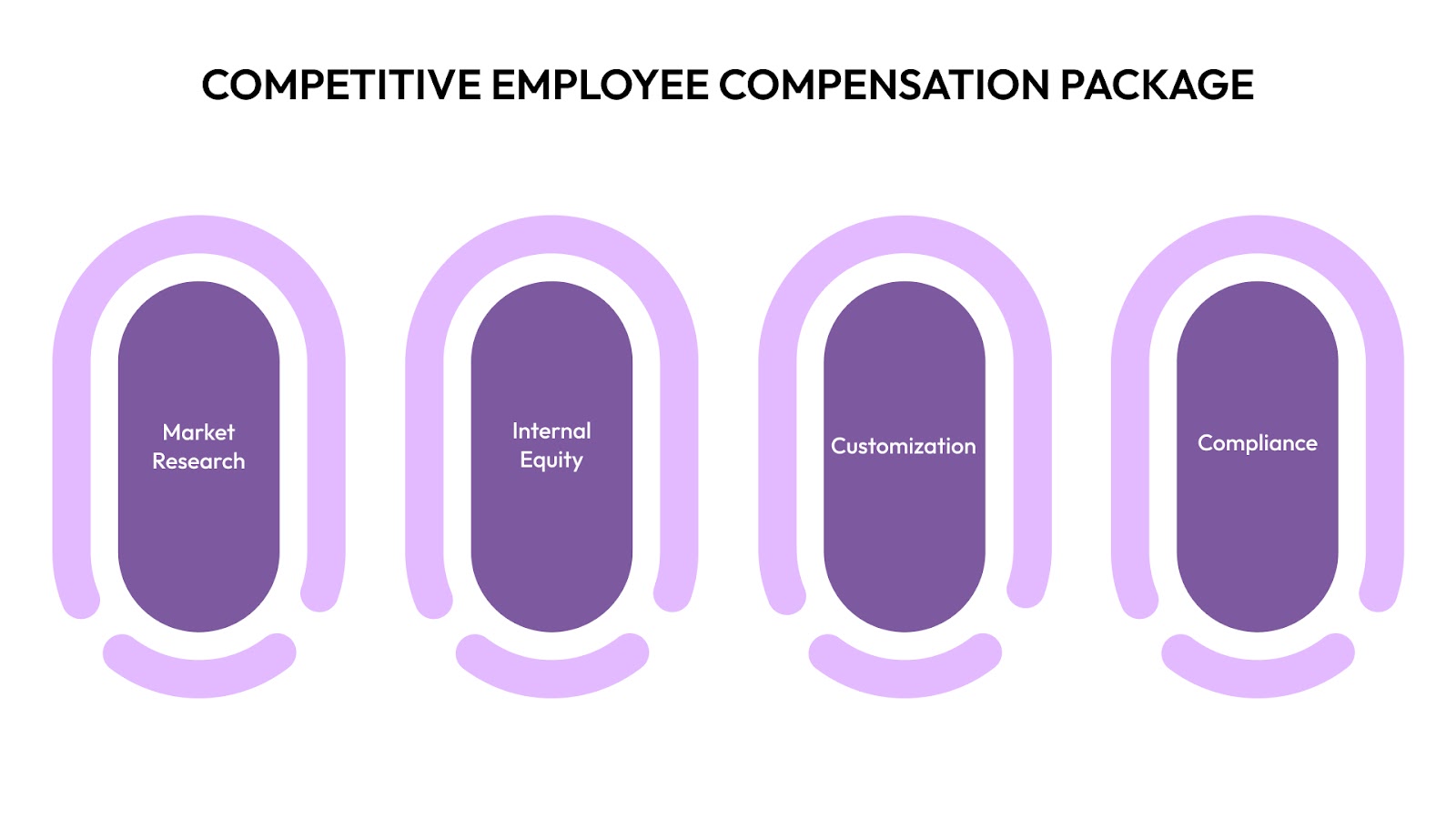
Designing a well-rounded employee compensation package requires balancing several elements to meet both employee needs and company goals.
Market Research
To design a competitive compensation package, it’s essential to benchmark against industry standards. Researching compensation and benefits data within your industry ensures that your offerings align with those of your competitors.
Utilizing salary surveys, industry reports, and consulting services can give insight into market trends and help establish fair pay ranges. This comparison helps you remain competitive, attracting the right talent while staying within budget.
Internal Equity
Ensuring fairness in compensation across roles and departments is key to fostering a positive company culture. Employees should feel that their compensation is equitable relative to the value they provide to the organization.
By implementing an internal equity system, you can evaluate pay structures across similar roles and ensure that employees performing similar tasks are compensated fairly. This prevents pay disparities and promotes trust and loyalty within the team.
Customization
Offering flexibility within your compensation structure allows employees to choose benefits that best suit their individual needs. Options like childcare assistance, wellness programs, or additional PTO can be tailored to meet varying life stages and preferences.
Customizable benefits not only improve employee satisfaction but also help with employee retention, as employees feel the company truly cares about their personal well-being.
Compliance
Adhering to labor laws and minimum wage requirements is a non-negotiable aspect of designing a competitive compensation package. Ensure your package meets all relevant legal requirements, such as overtime pay, workers’ compensation, and local or state-specific regulations.
Beyond just legal compliance, it’s important to consider pay equity and eliminate any gender, racial, or other pay gaps that could result in legal and reputational risk for your organization.
Now that we’ve covered the essentials of building a competitive compensation package, let's see how CandorIQ can help simplify this process for you.
How CandorIQ Helps with Employee Compensation and Benefits
CandorIQ helps you simplify the process and ensure that compensation practices are transparent, competitive, and aligned with company goals.
1. Centralized Platform
CandorIQ centralizes all aspects of employee compensation and benefits, optimizing the management process by bringing together all related tools in one unified platform.
- Unified System: From managing pay bands to headcount planning, CandorIQ brings everything together in a single system, removing the need for multiple spreadsheets or disconnected tools.
- Improved Efficiency: By consolidating tasks into one platform, HR teams can save time, reduce errors, and focus on more strategic aspects of compensation planning.
- Clear Structure: The platform provides transparency across the organization, making it easy to track and manage compensation structures and ensure they align with company-wide goals.
Simplify your compensation management with CandorIQ’s centralized platform
2. Compensation & Payband Builder
CandorIQ’s Compensation & Payband Builder helps you define and organize pay structures across roles, departments, and geographic locations, ensuring clarity and fairness in compensation decisions.
- Pay Equity: The tool allows businesses to create clear pay bands that reflect market trends, job levels, and internal equity, helping organizations improve pay equity.
- Data-Driven Decisions: By using benchmark datasets, CandorIQ helps ensure compensation remains competitive in the market while also considering company budgets and goals.
- Version Control: The system tracks changes and updates to pay bands, providing an audit trail for transparency and compliance.
Create fair, data-driven pay structures with CandorIQ’s Compensation & Payband Builder
3. Real-Time Collaboration
With CandorIQ, HR and finance teams can collaborate in real-time to align compensation packages with company goals and available budgets.
- Smooth Communication: By allowing HR and finance teams to work together within a single platform, CandorIQ reduces delays and miscommunication in compensation decisions.
- Budget Alignment: It ensures that compensation offerings are aligned with the company's budget, helping control costs while offering competitive benefits.
- Improved Decision-Making: Real-time feedback and updates allow teams to make quick, informed decisions based on current data, ensuring that all compensation decisions are consistent with company strategies.
4. Geo-Adjusted Compensation
CandorIQ provides a geo-adjusted compensation feature, allowing companies to account for location-based salary adjustments. This ensures fairness in compensation across different regions.
- Fair Pay Across Regions: Businesses with remote or distributed teams can ensure that their compensation packages are fair across different geographical locations, even if the cost of living varies.
- Market Competitive: CandorIQ adjusts compensation based on regional benchmarks, helping companies stay competitive in different markets while maintaining consistency in pay equity.
- Customization: The geo-adjustment feature allows businesses to customize compensation packages based on location, making it easier to manage compensation for a global workforce.
With CandorIQ’s comprehensive tools, managing employee compensation and benefits becomes a strategic advantage that drives organizational success and employee satisfaction.
Optimize your compensation strategy with CandorIQ!
Next, let’s explore the latest trends related to employee compensation benefits.
Trends in Employee Compensation Benefits
Employee compensation benefits are changing with time. Here’s a look at the latest trends shaping compensation strategies, as businesses aim to stay competitive while meeting employee expectations.
Pay Equity
Pay equity has become a central focus for many organizations. Companies are putting in more effort to address gender pay gaps and ensure fair compensation across all groups. To build trust and fairness, businesses are becoming more transparent by sharing pay data to track and reduce gaps, particularly between men and women, as well as other groups.
As laws around pay equity continue to develop, companies are facing greater pressure to meet these standards, which also support efforts to promote diversity and inclusion within the workplace.
Remote Work Compensation
With remote work becoming more common, companies are adjusting their compensation plans based on where employees are located. To ensure fairness, many organizations are considering the cost-of-living differences between regions when deciding how much to pay.
This means employees in cities with a higher cost of living may receive higher compensation than those in areas with a lower cost. Companies are also adjusting their pay models for hybrid work, ensuring that remote employees are fairly compensated for their work while keeping them satisfied and engaged.
These trends highlight a shift towards more personalized, transparent, and flexible employee compensation and benefits strategies.
Wrapping up
For HRBPs, CPOs, and finance teams, managing employee compensation benefits can be challenging, especially when trying to balance fairness, competitiveness, and compliance.
CandorIQ solves key challenges for every team. It simplifies employee compensation and benefits management by offering an all-in-one platform so that your compensation strategies are competitive, fair, and aligned with your business goals.
Discover how CandorIQ optimizes your workforce spend. Book a demo today!
FAQs
Q1. Who qualifies for a compensation and benefits package?
A1. Typically, full-time employees qualify for a compensation and benefits package. Eligibility for part-time, temporary, or freelance workers depends on company policy and the terms of their employment agreement.
Q2. Where do employee benefits appear in total compensation?
A2. Employee benefits make up a significant portion of total compensation. While the base salary is the primary component, benefits like health insurance, retirement plans, and paid time off (PTO) are integral to the overall compensation value.
Q3. When should companies review compensation and benefits packages?
A3. Companies should review their compensation and benefits packages regularly, especially during annual budgeting, after business changes (e.g., mergers), or when facing employee dissatisfaction or high turnover rates. Periodic reviews ensure competitiveness and employee retention.
Q4. What are fringe benefits in relation to employee compensation?
A4. Fringe benefits are additional non-wage compensations, such as company-provided vehicles, paid training, or wellness programs. While not mandatory, they enhance the overall employee compensation benefits package.
Q5. Which form of compensation is not considered an employee benefit?
A5. Direct financial compensation, like base salary, performance bonuses, and commissions, is not considered an employee benefit. Employee benefits are typically non-cash rewards, like insurance or paid leave.


